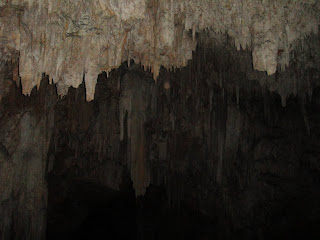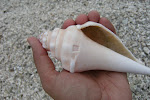I wrote a little about sling stones in my
blog about trying to replicate them using modern tools. The Chamorro name for sling stone is
acho' atupat (or
atupak) and were produced in the Latte Period/Phase (1000-250 BP). History books describe them as egg or acorn-shaped stones fashioned with “jasper-like” stone, or with sun or fire-hardened clay. People now use the words biconical or football-shaped to describe them. The ancient people wielded them with deadly accuracy. The biconical shape of the Chamorro sling stone is supposed to be state of the art as compared to sling stone designs from other parts of the world.
Pictured below are views of two different examples that were found in Wing Beach or what was known by the ancients as the Chamorro village of Luyo.

I noticed that these are more like flattened or deflated footballs. The views on the left are the top and bottom views typical of what a Chamorro sling stone should look like. I composited the different views of the two "flattened"
acho' atupat into the picture above for your study and enjoyment. These are clearly flatter stones.
Maybe the flattened shape was a sign of design development? Was this shape specific to a certain purpose? One day, I hope someone studies what the different shapes were good for. The ancient people were truly amazing craftsmen.
Ti napu.The Beachcomber

 Two years ago, Bernie and Johnny went with me to the Smithsonian. We had a blast. Johnny is from Pohnpei, FSM and was exited to see that the museum had a Yappese stone money. I hope we have time to visit there again. So many meetings though....sigh...
Two years ago, Bernie and Johnny went with me to the Smithsonian. We had a blast. Johnny is from Pohnpei, FSM and was exited to see that the museum had a Yappese stone money. I hope we have time to visit there again. So many meetings though....sigh...

 Cave I
Cave I







































 They both had three weird holes on their sides. I've never seen seeds with three holes on the side though. Maybe they are made of plastic and the holes were for lines, like a float. "Dull" had a pointy top crown though that made it look organic. Plus, if they were manufactured then they would have been molded into the same side.
They both had three weird holes on their sides. I've never seen seeds with three holes on the side though. Maybe they are made of plastic and the holes were for lines, like a float. "Dull" had a pointy top crown though that made it look organic. Plus, if they were manufactured then they would have been molded into the same side.

 The corozo palm nut polishes quite nicely and people in Central America still use them as
The corozo palm nut polishes quite nicely and people in Central America still use them as  We met RC via
We met RC via 

























 Maple leaf-shaped leaves? Big football-like fruits? What is that? I don't know what kind of tree that is? Wow! A mystery tree!
Maple leaf-shaped leaves? Big football-like fruits? What is that? I don't know what kind of tree that is? Wow! A mystery tree!






